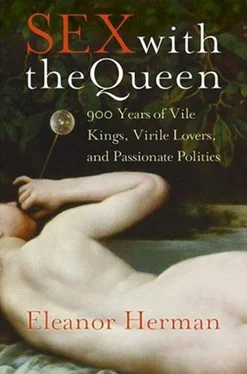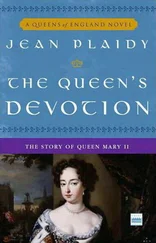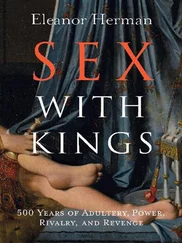This virgin queen replaced the dazzling images of Mary with dazzling images of herself. Courtiers, who a generation earlier had worshiped images of the Virgin Queen of Heaven, now bowed down before images of the virgin queen of England. Elizabeth even borrowed symbols traditionally associated with Jesus’s mother in religious art—the moon, the phoenix, the ermine, and the pearl. English subjects felt it was no coincidence that Elizabeth was born on September 7, the eve of the Feast of the Virgin, and died on March 24, the eve of the Annunciation of the Virgin.
Though Elizabeth most closely resembled the Virgin Mary in her probable physical virginity as well as her iconography, her single state confounded all of Europe. The ideal was to be like the Virgin, not be a virgin. Many didn’t fall for the virgin story at all; they said the queen did not marry because she refused to confine her lusts to one man. While some protested a bit too much about Elizabeth’s insatiable desires, claiming she even had sex with certain foreigners who were known to have enormous private parts, others declared the poor queen never married because she suffered from a genital deformity which prevented sex and childbearing. The Venetian ambassador in France heard that her menstrual cycle flowed out of one of her legs rather than the usual place.
Most likely, the queen’s single state was due neither to frigidity nor nymphomania nor deformity. The tragic fates of her mother and stepmothers at Henry VIII’s hands must have nurtured a horror of marriage that grew like a cancer in her belly. She once told the ambassador to the duchy of Württemberg, “I would rather be a beggar and single than a queen and married.” 4To the French envoy she stated, “When I think of marriage, it is as though my heart were being dragged out of my vitals.” 5
By the time of Elizabeth’s death in the early seventeenth century, virgin worship was less prominent in those countries which remained Catholic after the Reformation. The result was a more secular, relaxed lifestyle, in which the queen was viewed as a flesh-and-blood woman with faults and foibles, not as a chiseled stone statue interceding with God. But the intertwined images of Virgin Mary and queen had been hammered into the social subconscious for a thousand years and, though less pivotal in daily life, still existed. As both Virgin and queen had borne a princely savior with a sacred father, a queen whose behavior cast doubt upon the paternity of her son must have left a sour taste in the mouth of many a good Christian.
Royal blood was almost always passed down from kingly father to princely son—via a uterus where the child incubated for nine months. The strict refusal of that uterus to harbor any but royal seed was of the utmost importance to keeping the bloodline pure. It was the myth of royal blood that kept kings seated firmly on their thrones, prevented civil war, held foreign invaders at bay, and kept a superstitious people groveling before their monarch and paying the exorbitant taxes he required.
The myth started long ago when, shrouded by the mists of time, a bold warrior rode into battle swinging his sword and conquered his enemies. Chosen king by his grateful admirers, he continued to destroy adversaries, appease a wrathful deity, and rule with wisdom—sure signs that he was God’s chosen. Grasping at the mirage of immortality on earth, the aging monarch wanted to ensure that a part of him—his own flesh and blood—would rule after his death. But what if the king’s son was sickly, effeminate, weak-minded? How to convince the people that they must accept this poor specimen of manhood as their king rather than choosing instead a fearless warrior from a rival family?
And so the myth was born which declared that the king’s connection with God, his divine right to rule, was manifested in his blood—rather than his intelligence, looks, or temperament—and could be passed on to future generations. True, the myth of royal blood often ensured a stable transition of power from father to son instead of a bloody fracas of maces and battle-axes to determine who would be the new king. But it also resulted in countless insane monarchs, dribbling onto their chins and cackling, while millions of subjects bowed down to them in worshipful reverence. Insane they might be, but that sacred stuff coursing through their veins, the mystical royal blood, made them better than anyone else, made them God’s chosen to rule.
A scientific means of establishing paternity was not developed until the blood test of 1927. Until then, to ensure that the next generation of royals possessed the sanctified substance, the queen had to maintain strict fidelity to her husband. The ancient double standard—men rutting with mistresses while their wives sewed altar cloths—was rooted not in misogyny, but in biology.
“Consider of what importance to society the chastity of women is,” said the renowned wit and scholar Dr. Samuel Johnson, who wrote the first English dictionary in 1757. “Upon that all the property in the world depends. We hang a thief for stealing a sheep, but the unchastity of a woman transfers sheep, and farm, and all from the right owner.” 6
In 1695 Louis XIV’s sister-in-law, Elizabeth Charlotte, the duchesse d’Orléans, wrote, “Where in the world is a prince to be found who loves his wife only, and has no one else? If their wives on that account were to lead the same kind of life that they do, no one could be sure that their children were the true heirs.” Referring to a young relative who had committed adultery, she added, “Doesn’t this Duchess know that a wife’s honor consists in giving herself to nobody but her husband, whereas for the husband there is no shame in having mistresses but only in being made a cuckold?” 7
Considering the emphasis on the royal bloodline, it is ironic that courts were littered, not just with the king’s bastards, but with the queen’s bastards as well; in her case these were children who bore the name of the kingly house, children who married into other royal families based on ancestry they did not, in fact, possess. With regard to royal children, the only consideration more important than their kingly blood was the monarch’s self-interest. Many kings acknowledged children they knew had been fathered by someone else. Often, kings did not want to cast doubt on the paternity of older children they knew to be their own. In the case where the king could not father children, sometimes court factions heartily desired the queen to bear bastards in order to stabilize the throne and cement their own interests.
Fortunately, the queen’s complete and utter disillusionment with her husband usually set in after the birth of the heir. And so it was not deemed worthwhile to lose international prestige, throw the nation into tumult, and question the paternity of all royal children, simply to deny the one cuckoo in the robin’s nest. In the early nineteenth century, the last son of King John VI and Queen Carlota Joaquina of Portugal was extremely good-looking and slender—unlike either of his parents—and happened to be the spitting image of the handsome gardener at the queen’s country retreat. Other than a few snickers behind painted fans, no one said a word.
More recently, the love affairs of Diana, Princess of Wales, created doubt about the paternity of her second son, Prince Harry, born in 1984. When Prince Charles first glanced at his newborn, he expressed alarm at the child’s red hair. Diana often spoke of this moment as the point where her marriage was over. Charles, who had been hoping for a daughter, was disappointed that his wife had presented him with another boy, and worse, that the child had red hair, which Charles disliked. There is, however, a different way of interpreting Charles’s irritation at his son’s hair color. If he had suspected that Diana had been having an affair with a red-haired man, then his reaction would have been quite understandable.
Читать дальше












